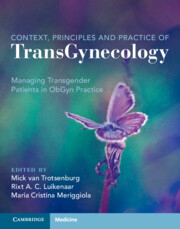Book contents
- Context, Principles, and Practice of Transgynecology
- Context, Principles, and Practice of Transgynecology
- Copyright page
- Dedication
- Contents
- Foreword
- Preface
- Contributors
- Abbreviations
- Section A Contextual Transgynecology
- Section B Practicing Transgynecology
- Chapter 9 Gynecological Office Medicine for Trans and Gender Diverse People
- Chapter 10 Features of Imaging in Transgender Persons
- Chapter 11 Benign Gynecological Conditions in Transgender and Gender Diverse People
- Chapter 12 Urogynecological Disorders
- Chapter 13 Painful and Frequent Micturition
- Chapter 14 Diagnostics and Treatment of Gynecological and Nongynecological Causes of Pelvic Pain
- Chapter 15 Gynecological Attention to the Prostate
- Chapter 16 Vaginal Dilators and Dilating after Vaginoplasty
- Chapter 17 Transenology
- Section C Gynecological Surgery for Transgender Males
- Section D Sexuality and Contraception
- Section E Fertility and Reproduction
- Section F Impact of Gender-affirming Hormonal Therapy on Genital Organs
- Section G Screening and Prophylaxis
- Transgynecology Index
- References
Chapter 14 - Diagnostics and Treatment of Gynecological and Nongynecological Causes of Pelvic Pain
from Section B - Practicing Transgynecology
Published online by Cambridge University Press: 22 December 2022
- Context, Principles, and Practice of Transgynecology
- Context, Principles, and Practice of Transgynecology
- Copyright page
- Dedication
- Contents
- Foreword
- Preface
- Contributors
- Abbreviations
- Section A Contextual Transgynecology
- Section B Practicing Transgynecology
- Chapter 9 Gynecological Office Medicine for Trans and Gender Diverse People
- Chapter 10 Features of Imaging in Transgender Persons
- Chapter 11 Benign Gynecological Conditions in Transgender and Gender Diverse People
- Chapter 12 Urogynecological Disorders
- Chapter 13 Painful and Frequent Micturition
- Chapter 14 Diagnostics and Treatment of Gynecological and Nongynecological Causes of Pelvic Pain
- Chapter 15 Gynecological Attention to the Prostate
- Chapter 16 Vaginal Dilators and Dilating after Vaginoplasty
- Chapter 17 Transenology
- Section C Gynecological Surgery for Transgender Males
- Section D Sexuality and Contraception
- Section E Fertility and Reproduction
- Section F Impact of Gender-affirming Hormonal Therapy on Genital Organs
- Section G Screening and Prophylaxis
- Transgynecology Index
- References
Summary
Pelvic pain can affect every human being. Because surgical and medical transition can lead to changes in anatomy and physiology, the work-up of pelvic pain in transgender patients may differ from cisgender patients. Masculinizing and feminizing hormone therapy can influence the differential diagnosis by increasing (e.g. gastric motility concerns on estrogen) and decreasing (e.g. ovulation-related pain on testosterone) certain pathologies’ frequency. Gender-affirming surgeries can introduce new anatomy (e.g. vaginoplasty) as well as remove anatomy (e.g. hysterectomy), which may influence pelvic pain. Transgender people may also have psychological and social factors which can influence their risk for or management of pain. Little evidence exists to guide understanding how the diagnosis, evaluation, and management of pelvic pain differs in the transgender community, but a few key considerations are emerging in the literature and will be addressed in this chapter.
- Type
- Chapter
- Information
- Context, Principles and Practice of TransGynecologyManaging Transgender Patients in ObGyn Practice, pp. 103 - 113Publisher: Cambridge University PressPrint publication year: 2022



